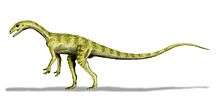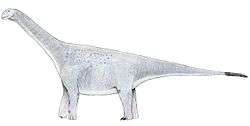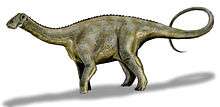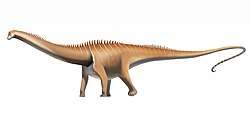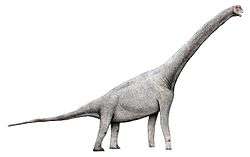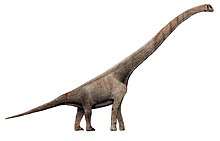Tataouinea
Tataouinea is an extinct genus of sauropod dinosaur in the subfamily Rebbachisaurinae of Rebbachisauridae which lived in the Early Cretaceous Tunisia. Only one species, T. hannibalis, is known.[1]
| Tataouinea | |
|---|---|
| Reconstructed skeleton, with known elements in pink | |
| Scientific classification | |
| Kingdom: | Animalia |
| Phylum: | Chordata |
| Clade: | Dinosauria |
| Clade: | Saurischia |
| Suborder: | †Sauropodomorpha |
| Clade: | †Sauropoda |
| Family: | †Rebbachisauridae |
| Genus: | †Tataouinea Fanti et al., 2013 |
| Species: | †T. hannibalis |
| Binomial name | |
| †Tataouinea hannibalis Fanti et al., 2013 | |
Discovery and naming
The first known elements of the holotype were discovered in 2011 by Aldo Luigi Bacchetta but he was unable to excavate the specimen until 2012. The remains were subsequently studied by Federico Fanti, Andrea Cau, Mohsen Hassine and Michela Contessi. The genus was named in 2013[1] and in 2015, more material of the holotype specimen was uncovered after the initial description were analysed.[2] These included additional tail vertebrae.
Description
Its bones were extensively pneumatic, providing strong support for the theory that sauropods had birdlike respiratory systems. Key characteristics of its vertebral morphology show that Tatouinea was a rebbachisaurid, closely related to the nigersaurines of Europe.[1] A phylogenetic analysis was published alongside the paper, finding a clade of nigersaurines to include Rebbachisaurus, thus forcing the subfamily to be renamed Rebbachisaurinae.[2]
The exact size of Tataouinea is unknown, but comparison to similar sauropods indicates a size of about 13.5 metres (44 ft) meters long and a height of around 2.5 metres (8.2 ft) at the hips for the holotype individual.[1]
Etymology
The genus name bears the name of the region where it was discovered, Tataouine, and the epithet honours Hannibal, a Carthaginian punic military commander.
Classification
Tataouinea was placed in the Rebbachisaurinae by Fanti et al. (2015). The 2015 cladogram of Fanti et al. is shown below.[2]
| Rebbachisauridae |
| ||||||||||||||||||||||||||||||||||||||||||||||||||||||
Paleoecology
Tataouinea was discovered in the Jebel El Mra Member or the nearby Oum ed Diab Member of the Aptian-Albian Ain el Guettar Formation. It coexisted with an unnamed carcharodontosaurid, Carcharodontosaurus, Spinosaurus, the notosuchian Araripesuchus, an unnamed sauropod, an unnamed iguanodont, an unnamed ornithocheirid pterosaur, an unnamed species of Sarcosuchus and a species of fish known as Maswonia.[1][3]
References
- Federico Fanti; Andrea Cau; Mohsen Hassine & Michela Contessi (2013). "A new sauropod dinosaur from the Early Cretaceous of Tunisia with extreme avian-like pneumatization". Nature Communications. 4 (2080): 1–7. doi:10.1038/ncomms3080. PMID 23836048.
- Fanti, F.; Cau, A.; Cantelli, L.; Hassine, M.; Auditore, M. (2015). "New Information on Tataouinea hannibalis from the Early Cretaceous of Tunisia and Implications for the Tempo and Mode of Rebbachisaurid Sauropod Evolution". PLoS ONE. 10 (4): e0123475. doi:10.1371/journal.pone.0123475. PMC 4414570. PMID 25923211.
- BENTON, M. J., BOUAZIZ, S., BUFFETAUT, E., MARTILL, D. M., OUAJA, M., SOUSSI, M. & TRUEMAN, C. (2000): Dinosaurs and other fossil vertebrates from fluvial deposits in the Lower Cretaceous of southern Tunisia. Palaeogeography, Palaeoclimatology, Palaeoecology, 157: 227–246.
